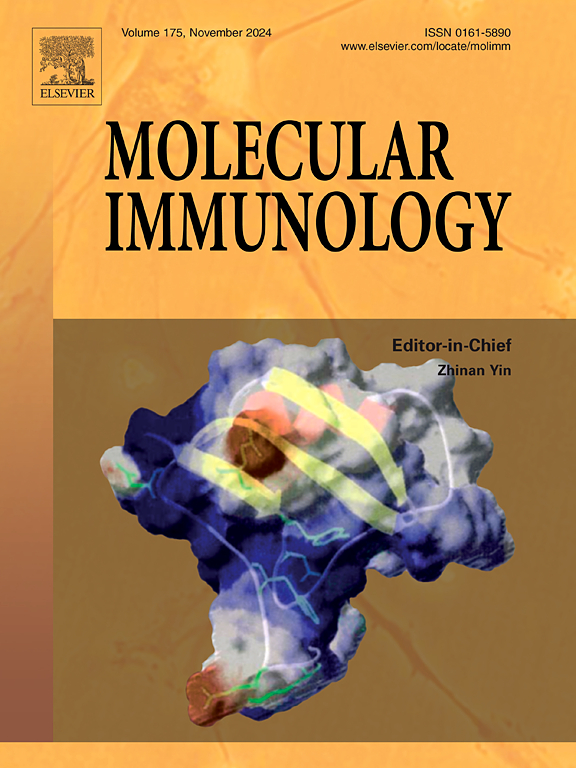YY1/INSIG1通过调节AMPK-mTOR信号通路促进动脉粥样硬化进展
IF 3
3区 医学
Q2 BIOCHEMISTRY & MOLECULAR BIOLOGY
引用次数: 0
摘要
目的胰岛素诱导基因1 (INSIG1)在动脉粥样硬化(AS)中的调控机制尚不清楚。本研究旨在探讨YY1/INSIG1轴及其对AMPK-mTOR信号通路的调控在AS发病中的作用。方法建立小鼠动脉粥样硬化模型。进行RNA测序以确定差异表达基因。用ox-LDL处理人脐静脉内皮细胞(HUVECs)和人血管平滑肌细胞(HVSMCs)和/或转染INSIG1质粒。通过增殖、迁移和炎症试验评估细胞功能。western blotting检测AMPK/mTOR通路的关键蛋白。转录因子YY1对INSIG1的调控通过双荧光素酶报告基因试验得到证实。关键是,在AS小鼠模型中,使用AMPK抑制剂(Dorsomorphin, DM)在体内验证了INSIG1-AMPK轴的功能作用。结果在动脉粥样硬化小鼠模型和患者中,sinsig1表达明显下调。在huvec中,INSIG1促进细胞增殖、迁移和侵袭,而在HVSMCs中,INSIG1抑制这些功能。较高的INSIG1水平降低了促炎介质IL-6和MCP-1。INSIG1过表达激活AMPK,抑制mTOR磷酸化。至关重要的是,在小鼠模型中,过量表达INSIG1的保护性抗动脉粥样硬化作用被AMPK抑制剂DM显著消除。生物信息学表明,YY1和INSIG1在动脉粥样硬化中可能存在相互作用,双荧光素酶报告基因实验证实了这一点,YY1直接调节INSIG1的mRNA转录。结论INSIG1和YY1与动脉粥样硬化及其治疗的相关性。本文章由计算机程序翻译,如有差异,请以英文原文为准。
YY1/INSIG1 enhances atherosclerosis progression by regulating AMPK-mTOR signaling
Objective
The regulatory mechanisms of Insulin-Induced Gene 1 (INSIG1) in atherosclerosis (AS) remain largely unknown. This study aimed to investigate the role of the YY1/INSIG1 axis and its regulation of the AMPK-mTOR signaling pathway in AS pathogenesis.
Methods
Atherosclerosis mouse models were established. RNA sequencing was performed to determine differentially expressed genes. Human umbilical vein endothelial cells (HUVECs) and human vascular smooth muscle cells (HVSMCs) were treated with ox-LDL and/or transfected with plasmids for INSIG1. Cellular functions were evaluated by proliferation, migration, and inflammation assays. Key proteins in the AMPK/mTOR pathway were measured by western blotting. The regulation of INSIG1 by transcription factor YY1 was confirmed using a dual-luciferase reporter assay. Crucially, the functional role of the INSIG1-AMPK axis was validated in vivo using an AMPK inhibitor (Dorsomorphin, DM) in the AS mouse model.
Results
INSIG1 expression was significantly downregulated in atherosclerosis mouse models and patients. In HUVECs, INSIG1 promoted cell proliferation, migration, and invasion, while in HVSMCs, INSIG1 suppressed these functions. Higher INSIG1 levels reduced the proinflammatory mediators IL-6 and MCP-1. INSIG1 overexpression activated AMPK and inhibited mTOR phosphorylation. Crucially, in the mouse model, the protective anti-atherosclerotic effects of INSIG1 overexpression were significantly abolished by the administration of the AMPK inhibitor DM. Bioinformatics suggested a potential interaction between YY1 and INSIG1 in atherosclerosis, which was confirmed by a dual-luciferase reporter assay that demonstrated YY1 directly regulate the mRNA transcription of INSIG1.
Conclusion
These findings underscore the relevance of INSIG1 and YY1 in atherosclerosis and maybe in its treatment.
求助全文
通过发布文献求助,成功后即可免费获取论文全文。
去求助
来源期刊

Molecular immunology
医学-免疫学
CiteScore
6.90
自引率
2.80%
发文量
324
审稿时长
50 days
期刊介绍:
Molecular Immunology publishes original articles, reviews and commentaries on all areas of immunology, with a particular focus on description of cellular, biochemical or genetic mechanisms underlying immunological phenomena. Studies on all model organisms, from invertebrates to humans, are suitable. Examples include, but are not restricted to:
Infection, autoimmunity, transplantation, immunodeficiencies, inflammation and tumor immunology
Mechanisms of induction, regulation and termination of innate and adaptive immunity
Intercellular communication, cooperation and regulation
Intracellular mechanisms of immunity (endocytosis, protein trafficking, pathogen recognition, antigen presentation, etc)
Mechanisms of action of the cells and molecules of the immune system
Structural analysis
Development of the immune system
Comparative immunology and evolution of the immune system
"Omics" studies and bioinformatics
Vaccines, biotechnology and therapeutic manipulation of the immune system (therapeutic antibodies, cytokines, cellular therapies, etc)
Technical developments.
 求助内容:
求助内容: 应助结果提醒方式:
应助结果提醒方式:


